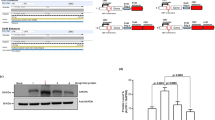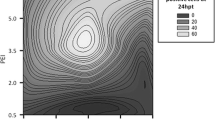Abstract
Our previous work showed that there is a limitation in the use of dihydrofolate reductase (dhfr)/methotrexate (MTX)-mediated gene amplification systems in dhfr-non-deficient HEK293 cells, as endogenous dhfr may interfere with the amplification process. In the present study, we successfully generated Epstein-Barr virus nuclear antigen-1 (EBNA-1)-amplified HEK293 cells in a dhfr-non-deficient HEK293 cell background using a single-plasmid vector-based gene amplification system with shRNA targeting the 3′-UTR of endogenous dhfr. The introduction of this shRNA efficiently downregulated the expression of endogenous dhfr in the HEK293 cells without affecting exogenous dhfr expression. The downregulation of endogenous dhfr improved the efficiency of EBNA-1 amplification, as evidenced by a comparison with the amplification extent in cells lacking shRNA expression at the same MTX concentration. The EBNA-1 expression levels from the EBNA-1-amplified clones selected in this study were higher than those obtained from EBNA-1-amplified clones that were generated using the conventional amplification in our previous study. Consistent with previous studies, EBNA-1 amplification improved the production of the Fc-fusion protein through a specific protein productivity (qp)-enhancing effect, rather than by improving cell growth or transfection efficiency. In addition, the N-glycan profiles in the Fc-fusion protein produced using this transient gene expression (TGE) system were not affected by EBNA-1 amplification. These results indicate the potential utility of EBNA-1-amplified mammalian cells, developed using a single-plasmid vector-based gene amplification system, for efficient protein production.
Key points
• EBNA-1-amplified HEK293 cells were established using gene amplification system.
• EBNA-1 amplification in TGE system can increase the Fc-fusion protein productivity.
• EBNA-1 amplification does not affect the N-glycan profile in the Fc-fusion protein.







Similar content being viewed by others
References
Baldi L, Hacker DL, Adam M, Wurm FM (2007) Recombinant protein production by large-scale transient gene expression in mammalian cells: state of the art and future perspectives. Biotechnol Lett 29(5):677–684. https://doi.org/10.1007/s10529-006-9297-y
Brummelkamp TR, Bernards R, Agami R (2002) A system for stable expression of short interfering RNAs in mammalian cells. Science 296(5567):550–553. https://doi.org/10.1126/science.1068999
Carter J, Zhang J, Dang TL, Hasegawa H, Cheng J, Gianan I, O’Neill JW, Wolfson M, Siu S, Qu S, Meininger D, Kim H, Delaney J, Mehlin C (2009) Fusion partners can increase the expression of recombinant interleukins via transient transfection in 2936E cells. Protein Sci 19(2):357–362. https://doi.org/10.1002/pro.307
Chin CL, Goh JB, Srinivasan H, Liu KI, Gowher A, Shanmugam R, Lim HL, Choo M, Tang WQ, Tan AH, Nguyen-Khuong T, Tan MH, Ng SK (2019) A human expression system based on HEK293 for the stable production of recombinant erythropoietin. Sci Rep 9(1):16768. https://doi.org/10.1038/s41598-019-53391-z
Durocher Y (2006) Expression vectors containing a truncated Epstein Barr Nuclear Antigen 1 lacking the Gly-Gly-Ala domain for enhanced transient gene expression. WO Patent 2006096989A2, 21 Sept 2006
Durocher Y, Perret S, Kamen A (2002) High-level and high-throughput recombinant protein production by transient transfection of suspension-growing human 293-EBNA1 cells. Nucleic Acids Res 30(2):E9. https://doi.org/10.1093/nar/30.2.e9
Hannon GJ (2002) RNA interference. Nature 418(6894):244-251. https://doi.org/10.1038/418244a
Heffernan M, Dennis JW (1991) Polyoma and hamster papovavirus large T antigen mediated replication of expression shuttle vectors in Chinese hamster ovary cells. Nucleic Acids Res 19(1):85–92. https://doi.org/10.1093/nar/19.1.85
Hong WW, Wu SC (2007) A novel RNA silencing vector to improve antigen expression and stability in Chinese hamster ovary cells. Vaccine 25(20):4103–4111. https://doi.org/10.1016/j.vaccine.2007.02.012
Hung SC, Kang MS, Kieff E (2001) Maintenance of Epstein–Barr virus (EBV) oriP-based episomes requires EBV-encoded nuclear antigen-1 chromosome-binding domains, which can be replaced by high-mobility group-I or histone H1. Proc Natl Acad Sci U S A 98(4):1865–1870. https://doi.org/10.1073/pnas.031584698
Jäger V, Büssow K, Wagner A, Weber S, Hust M, Frenzel A, Schirrmann T (2013) High level transient production of recombinant antibodies and antibody fusion proteins in HEK293 cells. BMC Biotechnol 13:52. https://doi.org/10.1186/1472-6750-13-52
Kang SY, Kim YG, Lee HW, Lee EG (2015) A single-plasmid vector for transgene amplification using short hairpin RNA targeting the 3′-UTR of amplifiable dhfr. Appl Microbiol Biotechnol 99(23):10117–10126. https://doi.org/10.1007/s00253-015-6856-y
Kennedy G, Sugden B (2003) EBNA-1, a bifunctional transcriptional activator. Mol Cell Biol 23(19):6901–6908. https://doi.org/10.1128/mcb.23.19.6901-6908.2003
Kirchmaier AL, Sugden B (1997) Dominant-negative inhibitors of EBNA-1 of Epstein-Barr virus. J Virol 71(3):1766–1775
Kusumoto KI, Akao T, Mizuki E, Nakamura O (2006) Gene transfer effects on various cationic amphiphiles in CHO cells. Cytotechnology 51(2):57–66. https://doi.org/10.1007/s10616-006-9014-7
Lalonde ME, Durocher Y (2017) Therapeutic glycoprotein production in mammalian cells. J Biotechnol 251:128–140. https://doi.org/10.1016/j.jbiotec.2017.04.028
Lee JH, Jeong YR, Kim YG, Lee GM (2017a) Understanding of decreased sialylation of Fc-fusion protein in hyperosmotic recombinant Chinese hamster ovary cell culture: N-glycosylation gene expression and N-linked glycan antennary profile. Biotechnol Bioeng 114(8):1721–1732. https://doi.org/10.1002/bit.26284
Lee JH, Lim SM, Park SH, Min JK, Lee GM, Kim YG (2017b) Investigation of relationship between EBNA-1 expression level and specific foreign protein productivity in transient gene expression of HEK293 cells. Process Biochem 55:182–186. https://doi.org/10.1016/j.procbio.2017.01.020
Lee JH, Park JH, Park SH, Kim SH, Kim JY, Min JK, Lee GM, Kim YG (2018) Co-amplification of EBNA-1 and PyLT through dhfr-mediated gene amplification for improving foreign protein production in transient gene expression in CHO cells. Appl Microbiol Biotechnol 102(11):4729–4739. https://doi.org/10.1007/s00253-018-8977-6
Lee JH, Hansen HG, Park SH, Park JH, Kim YG (2019) Transient gene expression-based protein production in recombinant mammalian cells. In: Lee GM, Kildegaard HF (eds) Cell culture engineering—recombinant protein production, vol 9. Wiley-VCH, Weinheim, pp 49–72
Lufino MM, Edser PA, Wade-Martins R (2008) Advances in high-capacity extrachromosomal vector technology: episomal maintenance, vector delivery, and transgene expression. Mol Ther 16(9):1525–1538. https://doi.org/10.1038/mt.2008.156
Merten OW, Bakker WA, Vorlop J, Reiter M, Visnovsky G, Jäger V, Merabishvili M, Reichl U (2014) Virus production under suspension conditions. In: Meyer HP, Schimidhalter DR (eds) Industrial scale suspension culture of living cells. Wiley-VCH, Weinheim, pp 503–554
Mizuguchi H, Hosono T, Hayakawa T (2000) Long-term replication of Epstein-Barr virus-derived episomal vectors in the rodent cells. FEBS Lett 472(2-3):173–178. https://doi.org/10.1016/s0014-5793(00)01450-2
Moghimi SM, Symonds P, Murray JC, Hunter AC, Debska G, Szewczyk A (2005) A two-stage poly(ethylenimine)-mediated cytotoxicity: implications for gene transfer/therapy. Mol Ther 11(6):990–995. https://doi.org/10.1016/j.ymthe.2005.02.010
Noh SM, Sathyamurthy M, Lee GM (2013) Development of recombinant Chinese hamster ovary cell lines for therapeutic protein production. Curr Opin Chem Eng 2(4):391–397. https://doi.org/10.1016/j.coche.2013.08.002
Pham PL, Perret S, Doan HC, Cass B, St-Laurent G, Kamen A, Durocher Y (2003) Largescale transient transfection of serum-free suspension-growing HEK293 EBNA1 cells: peptone additives improve cell growth and transfection efficiency. Biotechnol Bioeng 84(3):332–342. https://doi.org/10.1002/bit.10774
Raymond C, Tom R, Perret S, Moussouami P, L'Abbé D, St-Laurent G, Durocher Y (2011) A simplified polyethylenimine-mediated transfection process for large-scale and high-throughput applications. Methods 55(1):44–51. https://doi.org/10.1016/j.ymeth.2011.04.002
Reisman D, Yates J, Sugden B (1985) A putative origin of replication of plasmids derived from Epstein-Barr virus is composed of two cis-acting components. Mol Cell Biol 5(8):1822–1832. https://doi.org/10.1128/mcb.5.8.1822
Smith DW, Sugden B (2013) Potential cellular functions of Epstein-Barr Nuclear Antigen 1 (EBNA1) of Epstein-Barr virus. Viruses 5(1):226–240. https://doi.org/10.3390/v5010226
Tanaka J, Miwa Y, Miyoshi K, Ueno A, Inoue H (1999) Construction of Epstein-Barr virus-based expression vector containing mini-oriP. Biochem Biophys Res Commun 264(3):938–943. https://doi.org/10.1006/bbrc.1999.1617
Wurm FM (2004) Production of recombinant protein therapeutics in cultivated mammalian cells. Nat Biotechnol 22(11):1393–1398. https://doi.org/10.1038/nbt1026
Yu DY, Noh SM, Lee GM (2016) Limitations to the development of recombinant human embryonic kidney 293E cells using glutamine synthetase-mediated gene amplification: methionine sulfoximine resistance. J Biotechnol 231:136–140. https://doi.org/10.1016/j.jbiotec.2016.06.003
Yu DY, Lee SY, Lee GM (2018) Glutamine synthetase gene knockout-human embryonic kidney 293E cells for stable production of monoclonal antibodies. Biotechnol Bioeng 115(5):1367–1372. https://doi.org/10.1002/bit.26552
Zhang J, Liu X, Bell A, To R, Baral TN, Azizi A, Li J, Cass B, Durocher Y (2009) Transient expression and purification of chimeric heavy chain antibodies. Protein Expr Purif 65(1):77–82. https://doi.org/10.1016/j.pep.2008.10.011
Funding
This work was supported by the National Research Foundation of Korea (NRF) grant funded by the Korea government (MEST) (No. NRF-2020R1A2C4001982) and a grant from KRIBB Initiative Program.
Author information
Authors and Affiliations
Contributions
SHP, JHP, YGK, and GML designed the research. YGK and GML supervised the project. SHP, JHP, and JHL conducted the main experiments. HML, YJK, EJL, and SS contributed protein purification and analyzed the data. SHP, JHP, YGK, and GML wrote the manuscript. All authors read and approved the manuscript.
Corresponding authors
Ethics declarations
Conflict of interest
The authors declare that they have no conflict of interest.
Ethical approval
This article does not contain any studies with human participants or animals performed by any of the authors.
Additional information
Publisher’s note
Springer Nature remains neutral with regard to jurisdictional claims in published maps and institutional affiliations.
Supplementary Information
ESM 1
(PDF 307 kb).
Rights and permissions
About this article
Cite this article
Park, SH., Park, JH., Lee, JH. et al. Amplification of EBNA-1 through a single-plasmid vector-based gene amplification system in HEK293 cells as an efficient transient gene expression system. Appl Microbiol Biotechnol 105, 67–76 (2021). https://doi.org/10.1007/s00253-020-11001-3
Received:
Revised:
Accepted:
Published:
Issue Date:
DOI: https://doi.org/10.1007/s00253-020-11001-3




